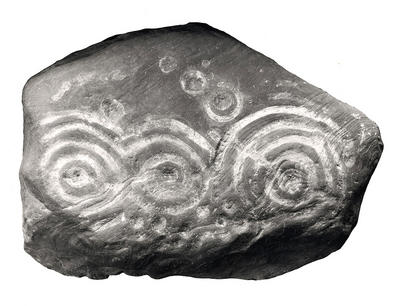
A sandstone boulder with cup and ring marks found in the Blue Bell Wood just south of Langside House. The style of decoration gets its name because it takes the form of circular indentations (cups) with rings round them.
Cup and ring marked stones seem to have been made by nomadic people as markers for special places. They are usually found on high ground offering viewpoints over valleys and plains. The stones face out towards the open sky.
Recent research has shown that this abstract rock art generally belongs to the neolithic period (c 4,000-2,500 BC) when nomadic hunter-gatherers began to settle down as farmers. This happened over a long time and while some settled quickly, others kept to the old ways. It seems to be this latter group who made the carvings. As the wandering lifestyle was slowly abandoned the use of rock art changed. Instead of being open to the sky, carved stones were buried with the dead in cairns and monuments. The use of cup and ring marked stones ended in the early bronze age.
Reference: 30
Reproduced with the permission of Glasgow City Council, Glasgow Museums
Keywords:
abstract art, archaeology, bronze age, carved stones, cup and ring marked stones, farmers, farming, hunter-gatherers, Langside House, neolithic, nomads, rock art, stone age
You have 0 images in your photo album.